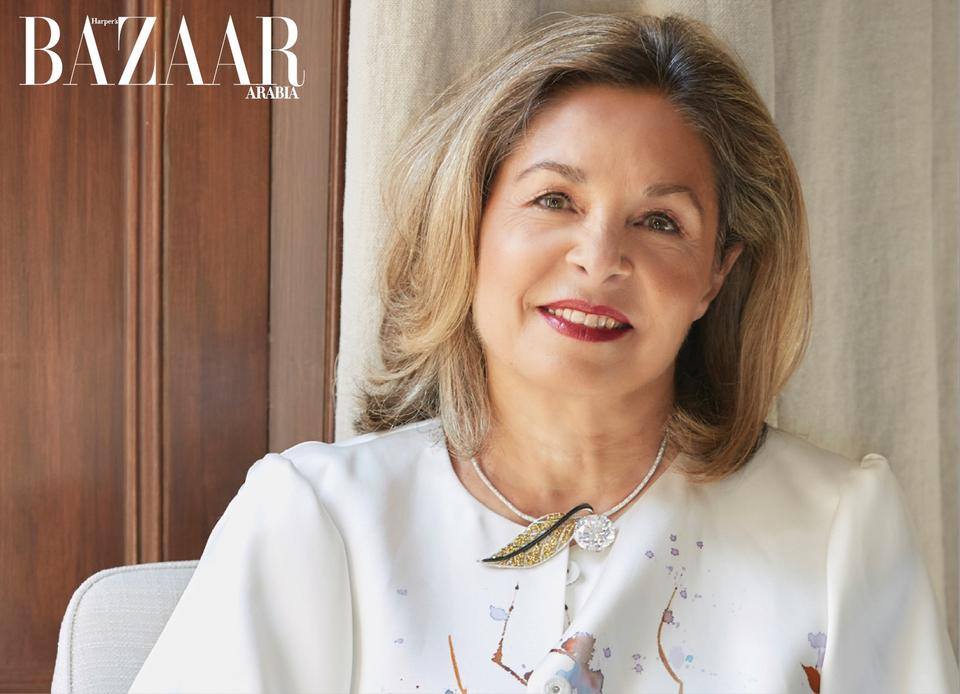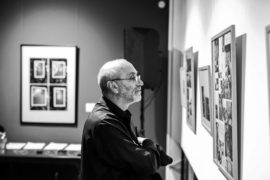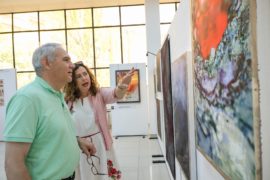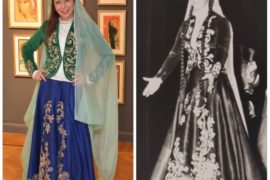The interview was conducted in May 2020 but is published now ahead of the Armenia Art Fair Online Edition by Lizzy Vartanian.
Harvard and Oxford educated, Roxane Zand DL, began a career in museum and arts administration after three years in UNESCO. She left Iran after the Revolution, and resumed professional activities in London where she was an Executive Officer of the Iran Heritage Foundation before moving to Asia House as their Special Projects Director. She is Arts Editor of the Ismaili Institute’s Encyclopaedia Islamica, and has worked freelance with the British Museum and elsewhere in the art world before joining Sothebys in 2006 as its Director for the Middle East and Gulf, subsequently becoming Deputy Chairman and Senior Director. Currently she sits on the Advisory Council of the Pictet Art Prize and has contributed to a number of publications on Arab and Iranian artists. She has been recognized by the Asian Women of Achievement Awards for her services to Middle East arts and culture.
Can you tell us a little about your background?
My life started in the museum world. I’m from Iran myself originally, and I was the first employee at the Tehran Museum of Contemporary Art and helped set it up. I’m very passionate about seeing the cultural growth in countries such as ours because the global art world is very dominant in western art, and it’s always wonderful to see fresh perspectives.
Your work has focused on the Middle East region where Armenians have had a big impact in the arts and cultural scene, especially in Lebanon and Iran. How do you think Armenians have made their presence known in that part of the world?
I think Armenians are one of the minorities that have been extremely good at integrating. The Armenians in Iran and Lebanon, although they had a sense of community, they integrated well and functioned as part of the mainstream. Take an artist like Paul Guiragossian, of course people know that he’s ethnically Armenian, but he’s very much a Lebanese artist, and he’s been very much part of the artistic canon that belongs to the Arab modernists. I think Armenian artists have integrated very well. In Iran there was Marcos Grigorian, Dawood , so there are quite a few well-respected artists across the region that I can think of that were of Armenian origin.
Do you think the Caucasus region has potential as an emerging art market?
If I had a glass ball and I could predict like that, I would be a very rich woman. Unfortunately, it is very difficult to predict, particularly in light of recent circumstances. We’ve had a series of very big economic events like Brexit and Trump’s policies. We have these major shifts in the world’s art market. As we see from the coronavirus situation, everything is interconnected these days. It’s a fallacy to think that yes, you can have the spread of a disease in one corner and Brexit in another, and nobody else is going to be affected. It does affect everyone in all different kinds of sectors. The art market is obviously connected transactionally to the economic situation. Difficulties happening in the UK have implications for the presentation of Armenian artists in art fairs as well as the travel of collectors to Armenia for the art fair. So, all of these things have implications because of the global way we live today. So I think yes, in that perspective, I think the world, certainly the art world, constantly welcomes newcomers to the scene. There’s curiosity, interest and appeal for collectors to find new areas, new cultures, new expressions, of course, there’s a huge interest in that. The art world and what art represents is all about journeys and discovery and the understanding of cultures, so yes, there’s a real interest and space for armenian art and an art fair to grow.
And what do you think given the current situation regarding the coronavirus pandemic?
I think the economic repercussions, especially in Iran, are going to be quite significant. At some point it will be a question of funding, what people can afford and so on. But I think all countries being equal, I think they will be very happy to come.
I have great confidence in the organisers of the fair. My concern is buyer confidence and collector confidence, if the collectors are feeling worried about travelling to Yerevan, that’s something that none of us can control. I’ve seen this happen in the past. It happened to Lebanon, they had a wonderful Picasso exhibition, many collectors were supposed to go but then people were worried and did not go. You can’t predict how people will react, but I do hope by June that confidence will have come back.
What are your expectations for the art fair?
I really look to discover new talents. For people in the art world, whether we’re at the consumption end of it, or the service provision of it, the whole industry is always excited by the discovery of new talent, of finding out new experimentation, modes of looking at the truth from another perspective. How people see the world from where they are standing. This is always an exciting thing and I look forward to seeing interesting art, and seeing examples of the realities of what’s happening in Armenia. We hear from news outlets, but coming to an art fair and looking at the artwork of Armenian artists will be a completely different, new perspective of what’s happening in your region. It’s another form of news reporting, it’s understanding the truth and realities of your region through a different set of eyes.
And what else are you looking for?
These sort of art fairs perform best if they are small but of good quality. I think it is unwise to expect something very ambitious when something is very, very new. So I would really look to see good selections, even if the fair is small. Speaking subjectively, relatively small is better because it allows me to digest a lot of new artists, discover their work, pay attention to their work, to be thoughtful to how I understand what I’m seeing.
Besides the art fair, is there anything in Armenia that you’re looking forward to discovering?
I think the discovery of the culture and the location is an important part of this experience. The first few editions of Art Dubai were very location focused, allowing people to take a look at the surroundings and discover the city, there was a real tourism angle in the first couple of years. So when people come and want to discover a new art scene, they need to understand the location as well. So seeing museums, looking around Yerevan, discovering the country, its geography, its history, that’s all part of the experience. And it will help with the success of the sales for the artists, because the more we’re understanding about what we’re seeing, the more we end up buying it, because you have to relate to something before you buy it.




